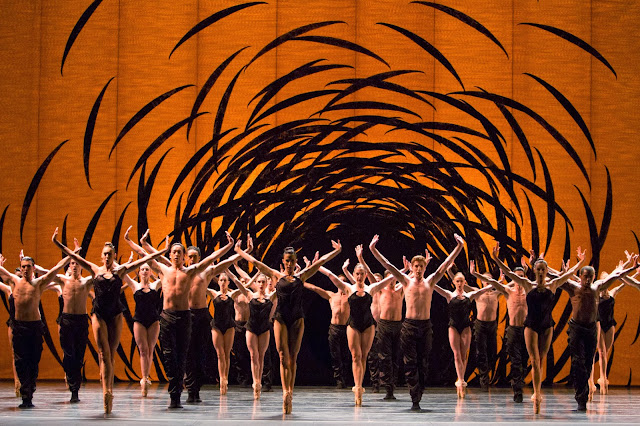 |
| PNB Principal Dancer Jonathan Porretta in "State of Darkness" by Molissa Fenley. Photo @ Angela Sterling |
Many years ago, a fellow journalist took me out for coffee. He was planning to write a profile of Seattle-based choreographer Pat Graney, and he wanted my advice on how to watch dance. Graney's "Faith" is one of those works that changed my life. I didn't have any sage words for him then. I do now, though. Today I'd tell my colleague you need to watch dance from your heart. Watch dance from your heart. I have a friend in Memphis who says he likes to settle into his seat, open all his chakras, and let the art pour in. Same idea.
One of the great privileges I've enjoyed throughout my career is access to art-in-progress. It's a little like peeking behind L. Frank Baum's curtain at the Wizard of Oz. What appears so effortless on a stage requires hours, weeks, even months of construction. Great dance is the result of learning, rehearsing, then, ultimately, embracing movement and making it your own. And the process is as fascinating as the final performance.
 |
| Choreographer Molissa Fenley performing her solo "State of Darkness" photo courtesy PNB |
In late December I got a chance to peek behind the curtain at Pacific Northwest Ballet. Choreographer Molissa Fenley was in Seattle to teach her 1988 solo "State of Darkness" to several company members.
It's a complex dance, set to Stravinsky's "Rite of Spring." Fenley made it for herself originally; other dancers have performed it since, including PNB Artistic Director Peter Boal.
On this particular winter afternoon, as weak sun streamed through the windows of the PNB rehearsal room, Fenley, Boal and three company principal dancers had gathered to work their way through Fenley's intricate choreography. As I watched Rachel Foster, James Moore and Jonathan Porretta try to absorb each jump, leg extension and delicate swirl of the hand, I didn't have open chakras or open heart. I had open jaw. I was watching three artists with three distinct and highly personal learning processes.
 |
| Choreographer Molissa Fenley working with PNB Principal Dancer Jonathan Porretta. Photo @ Angela Sterling |
To help teach this solo,Fenley had a 1990 videotape of one of her own performances. She said it was made early enough that the dance was still "pure." Because, of course, a dance changes every time it's performed. A videotape is a document of an ephemeral, singular moment in time. Clearly, this was one document Fenley believed to be accurate. As she played the tape and explained her solo for Foster, Moore and Porretta, Peter Boal moved through the steps himself, as if trying to remind his limbs, his torso and his mind what "State of Darkness" felt like when he danced it in 2000.
For Jonathan Porretta, this rehearsal was also a reminder. He performed Fenley's solo at PNB in 2007. As Porretta listened to Stravinsky's score, it seemed to prod his corporal memory, and he began to move, gaining confidence as the rehearsal went along. James Moore, on the opposite side of the studio, worked his way through the learning process with equal physicality. He'd watch the tape, then propel his muscular body through the steps he'd seen. By contrast to both men, Rachel Foster's process seemed far more cerebral. Brow furrowed, she studied the video intently, as if trying to absorb every last detail in her mind before it could travel to her body. Then she asked question and after question, to pin down the elusive and complex patterns Fenley had created. It was a reminder to me that while dance is transmitted from body to body, the artists also use their intellect to interpret and re-enact what they see.
 |
| PNB Principal Jonathan Porretta in "State of Darkness." Photo @ Angela Sterling |
After more than an hour of concentrated effort, Fenley suggested the three dancers run through what they'd gone over, this time without stops and starts. With their boss, Boal, dancing away in front of them, Moore, Porretta and Foster began to move. There were mistakes, omissions, timing issues, sure. But there was also that ineffable thrill of witnessing how the artists were able to imbue their unique essences into this one dance. Each version was slightly different; no better or worse. Distinct.
As the music ended, Jonathan Porretta started to laugh. "Good thing we have six weeks," he said.
Six weeks for me to anticipate, to get those chakras ready to open.
 |
| Molissa Fenley |
You can see "State of Darkness" on Pacific Northwest Ballet's "Director's Choice" program. It will be onstage at McCaw Hall March 14-23.















